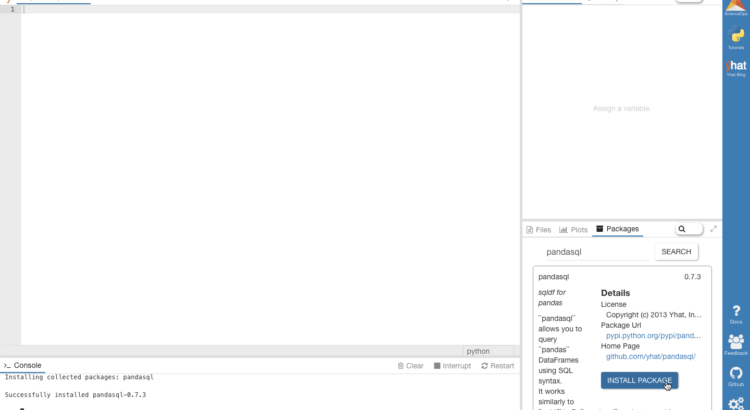Introduction
One of my favorite things about Python is that users get the benefit of observing the R community and then emulating the best parts of it. I’m a big believer that a language is only as helpful as its libraries and tools.
This post is about pandasql, a Python package we (Yhat) wrote that emulates the R package sqldf. It’s a small but mighty library comprised of just 358 lines of code. The idea of pandasql is to make Python speak SQL. For those of you who come from a SQL-first background or still “think in SQL”, pandasql is a nice way to take advantage of the strengths of both languages.
In this introduction, we’ll show you to get up and running with pandasql inside of Rodeo, the integrated development environment (IDE) we built for data exploration and analysis. Rodeo is an open source and completely free tool. If you’re an R user, its a comparable tool with a similar feel to RStudio. As of today, Rodeo can only run Python code, but last week we added syntax highlighting of a bunch of other languages to the editor view (mardown, JSON, julia, SQL, markdown). As you may have read or guessed, we’ve got big plans for Rodeo, including adding SQL support so that you can run your SQL queries right inside of Rodeo, even without our handy little pandasql. More on that in the next week or two!
Downloading Rodeo
Start by downloading Rodeo for Mac, Windows or Linux from the Rodeo page on the Yhat website.
ps If you download Rodeo and encounter a problem or simply have a question, we monitor our discourse forum 24/7 (okay, almost).
A bit of background, if you’re curious
Behind the scenes, pandasql uses the pandas.io.sql module to transfer data between DataFrame and SQLite databases. Operations are performed in SQL, the results returned, and the database is then torn down. The library makes heavy use of pandas write_frame and frame_query, two functions which let you read and write to/from pandas and (most) any SQL database.
Install pandasql
Install pandasql using the package manager pane in Rodeo. Simply search for pandasql and click Install Package.
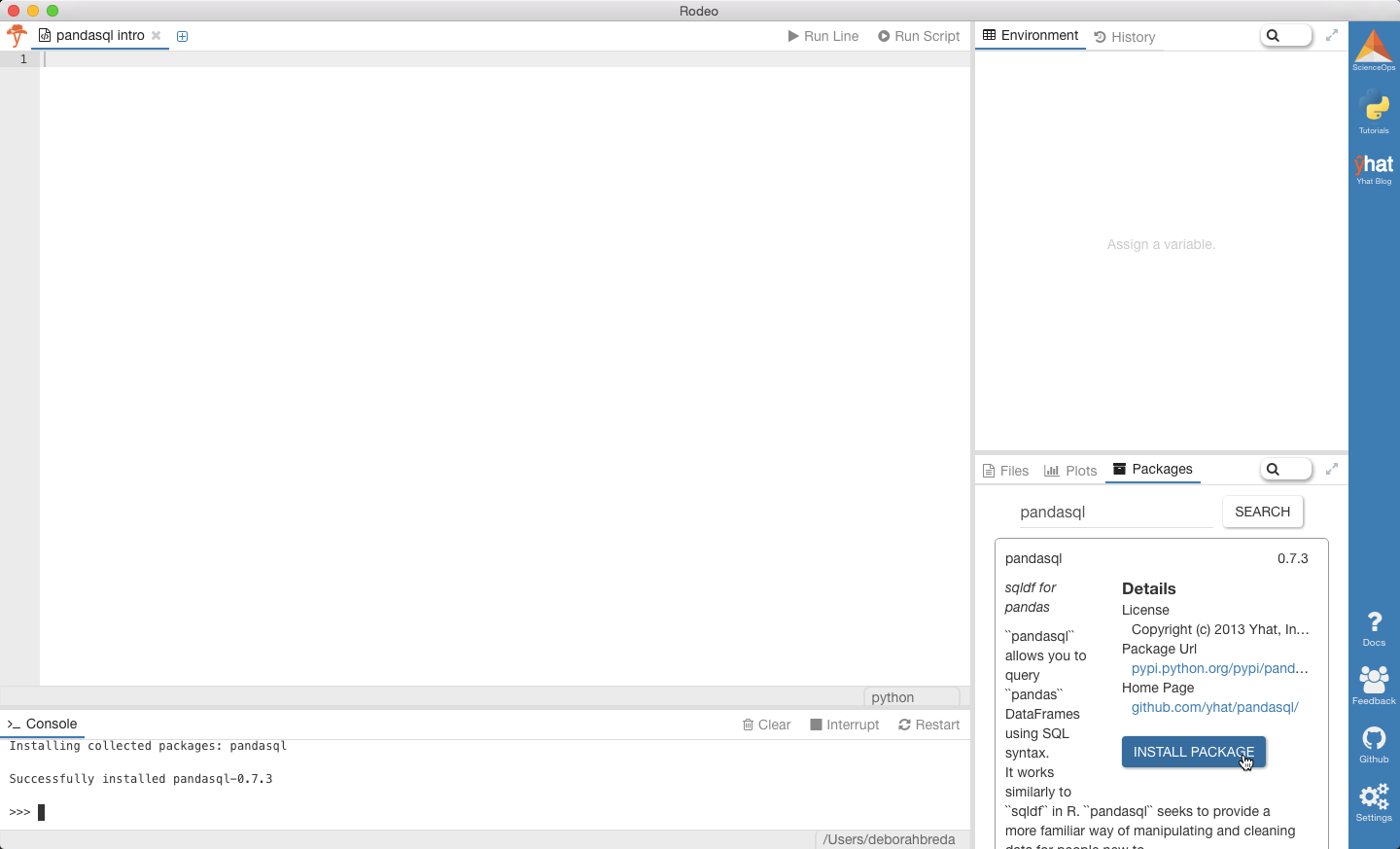
You can also run ! pip install pandasql from the text editor if you prefer to install that way.
Check out the datasets
pandasql has two built-in datasets which we’ll use for the examples below.
meat: Dataset from the U.S. Dept. of Agriculture containing metrics on livestock, dairy, and poultry outlook and productionbirths: Dataset from the United Nations Statistics Division containing demographic statistics on live births by month
Run the following code to check out the data sets.
#Checking out meat and birth data
from pandasql import sqldf
from pandasql import load_meat, load_births
meat = load_meat()
births = load_births()
#You can inspect the dataframes directly if you're using Rodeo
#These print statements are here just in case you want to check out your data in the editor, too
print meat.head()
print births.head()
Inside Rodeo, you really don’t even need the print.variable.head() statements, since you can actually just examine the dataframes directly.
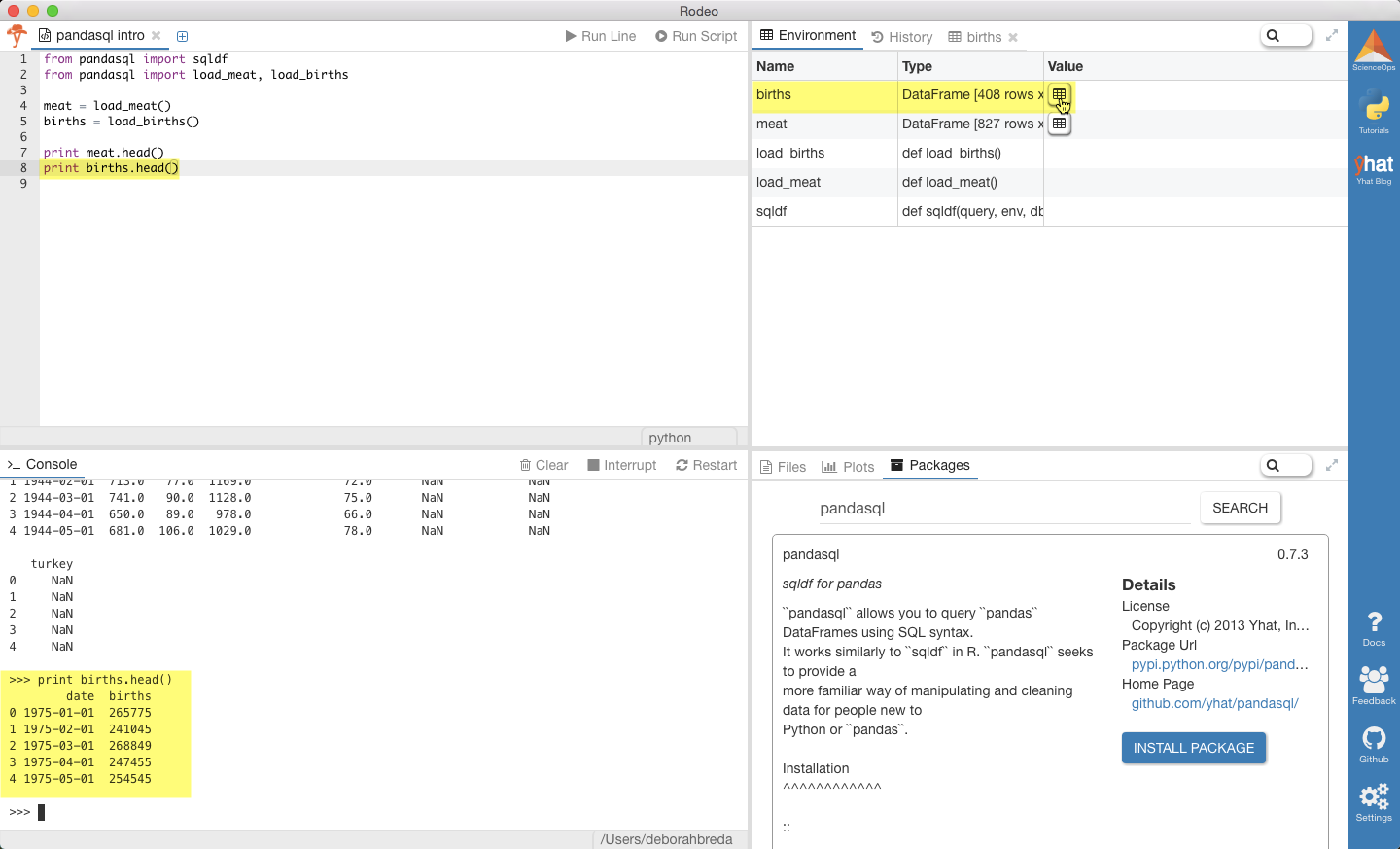
An odd graph
# Let's make a graph to visualize the data
# Bet you haven't had a title quite like this before
import matplotlib.pyplot as plt
from pandasql import *
import pandas as pd
pysqldf = lambda q: sqldf(q, globals())
q = """
SELECT
m.date
, m.beef
, b.births
FROM
meat m
LEFT JOIN
births b
ON m.date = b.date
WHERE
m.date > '1974-12-31';
"""
meat = load_meat()
births = load_births()
df = pysqldf(q)
df.births = df.births.fillna(method='backfill')
fig = plt.figure()
ax1 = fig.add_subplot(111)
ax1.plot(pd.rolling_mean(df['beef'], 12), color='b')
ax1.set_xlabel('months since 1975')
ax1.set_ylabel('cattle slaughtered', color='b')
ax2 = ax1.twinx()
ax2.plot(pd.rolling_mean(df['births'], 12), color='r')
ax2.set_ylabel('babies born', color='r')
plt.title("Beef Consumption and the Birth Rate")
plt.show()
Notice that the plot appears both in the console and the plot tab (bottom right tab).
Tip: You can “pop out” your plot by clicking the arrows at the top of the pane. This is handy if you’re working on muliple monitors and want to dedicate one just to your data visualzations.
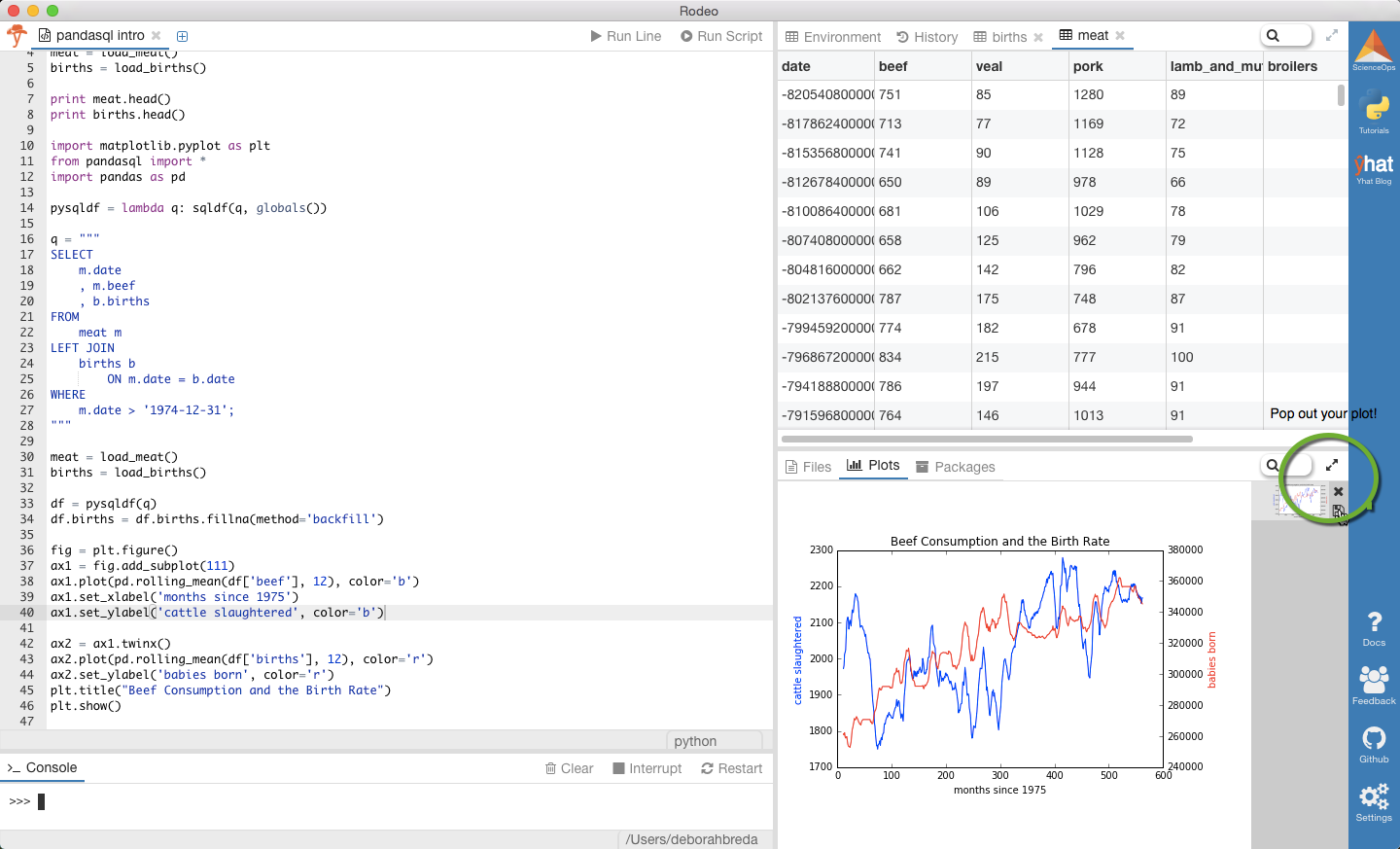
Usage
To keep this post concise and easy to read, we’ve just given the code snippets and a few lines of results for most of the queries below.
If you’re following along in Rodeo, a few tips as you’re getting started:
Run Scriptwill indeed run everything you have written in the text editor- You can highlight a code chunk and run it by clicking
Run Lineor pressing Command + Enter - You can resize the panes (when I’m not making plots I shrink down the bottom right pane)
Basics
Write some SQL and execute it against your pandas DataFrame by substituting DataFrames for tables.
q = """
SELECT
*
FROM
meat
LIMIT 10;"""
print sqldf(q, locals())
# date beef veal pork lamb_and_mutton broilers other_chicken turkey
# 0 1944-01-01 00:00:00 751 85 1280 89 None None None
# 1 1944-02-01 00:00:00 713 77 1169 72 None None None
# 2 1944-03-01 00:00:00 741 90 1128 75 None None None
# 3 1944-04-01 00:00:00 650 89 978 66 None None None
pandasql creates a DB, schema and all, loads your data, and runs your SQL.
Aggregation
pandasql supports aggregation. You can use aliased column names or column numbers in your group by clause.
# births per year
q = """
SELECT
strftime("%Y", date)
, SUM(births)
FROM births
GROUP BY 1
ORDER BY 1;
"""
print sqldf(q, locals())
# strftime("%Y", date) SUM(births)
# 0 1975 3136965
# 1 1976 6304156
# 2 1979 3333279
# 3 1982 3612258
locals() vs. globals()
pandasql needs to have access to other variables in your session/environment. You can pass locals() to pandasql when executing a SQL statement, but if you’re running a lot of queries that might be a pain. To avoid passing locals all the time, you can add this helper function to your script to set globals() like so:
def pysqldf(q):
return sqldf(q, globals())
q = """
SELECT
*
FROM
births
LIMIT 10;"""
print pysqldf(q)
# 0 1975-01-01 00:00:00 265775
# 1 1975-02-01 00:00:00 241045
# 2 1975-03-01 00:00:00 268849
joins
You can join dataframes using normal SQL syntax.
# joining meats + births on date
q = """
SELECT
m.date
, b.births
, m.beef
FROM
meat m
INNER JOIN
births b
on m.date = b.date
ORDER BY
m.date
LIMIT 100;
"""
joined = pysqldf(q)
print joined.head()
#date births beef
#0 1975-01-01 00:00:00.000000 265775 2106.0
#1 1975-02-01 00:00:00.000000 241045 1845.0
#2 1975-03-01 00:00:00.000000 268849 1891.0
WHERE conditions
Here's a `WHERE` clause.
q = """
SELECT
date
, beef
, veal
, pork
, lamb_and_mutton
FROM
meat
WHERE
lamb_and_mutton >= veal
ORDER BY date DESC
LIMIT 10;
"""
print pysqldf(q)
# date beef veal pork lamb_and_mutton
# 0 2012-11-01 00:00:00 2206.6 10.1 2078.7 12.4
# 1 2012-10-01 00:00:00 2343.7 10.3 2210.4 14.2
# 2 2012-09-01 00:00:00 2016.0 8.8 1911.0 12.5
# 3 2012-08-01 00:00:00 2367.5 10.1 1997.9 14.2
It’s just SQL
Since pandasql is powered by SQLite3, you can do most anything you can do in SQL. Here are some examples using common SQL features such as subqueries, order by, functions, and unions.
#################################################
# SQL FUNCTIONS
# e.g. `RANDOM()`
#################################################
q = """SELECT
*
FROM
meat
ORDER BY RANDOM()
LIMIT 10;"""
print pysqldf(q)
# date beef veal pork lamb_and_mutton broilers other_chicken turkey
# 0 1967-03-01 00:00:00 1693 65 1136 61 472.0 None 26.5
# 1 1944-12-01 00:00:00 764 146 1013 91 NaN None NaN
# 2 1969-06-01 00:00:00 1666 50 964 42 573.9 None 85.4
# 3 1983-03-01 00:00:00 1892 37 1303 36 1106.2 None 182.7
#################################################
# UNION ALL
#################################################
q = """
SELECT
date
, 'beef' AS meat_type
, beef AS value
FROM meat
UNION ALL
SELECT
date
, 'veal' AS meat_type
, veal AS value
FROM meat
UNION ALL
SELECT
date
, 'pork' AS meat_type
, pork AS value
FROM meat
UNION ALL
SELECT
date
, 'lamb_and_mutton' AS meat_type
, lamb_and_mutton AS value
FROM meat
ORDER BY 1
"""
print pysqldf(q).head(20)
# date meat_type value
# 0 1944-01-01 00:00:00 beef 751
# 1 1944-01-01 00:00:00 veal 85
# 2 1944-01-01 00:00:00 pork 1280
# 3 1944-01-01 00:00:00 lamb_and_mutton 89
#################################################
# subqueries
# fancy!
#################################################
q = """
SELECT
m1.date
, m1.beef
FROM
meat m1
WHERE m1.date IN
(SELECT
date
FROM meat
WHERE
beef >= broilers
ORDER BY date)
"""
more_beef_than_broilers = pysqldf(q)
print more_beef_than_broilers.head(10)
# date beef
# 0 1960-01-01 00:00:00 1196
# 1 1960-02-01 00:00:00 1089
# 2 1960-03-01 00:00:00 1201
# 3 1960-04-01 00:00:00 1066
Final thoughts
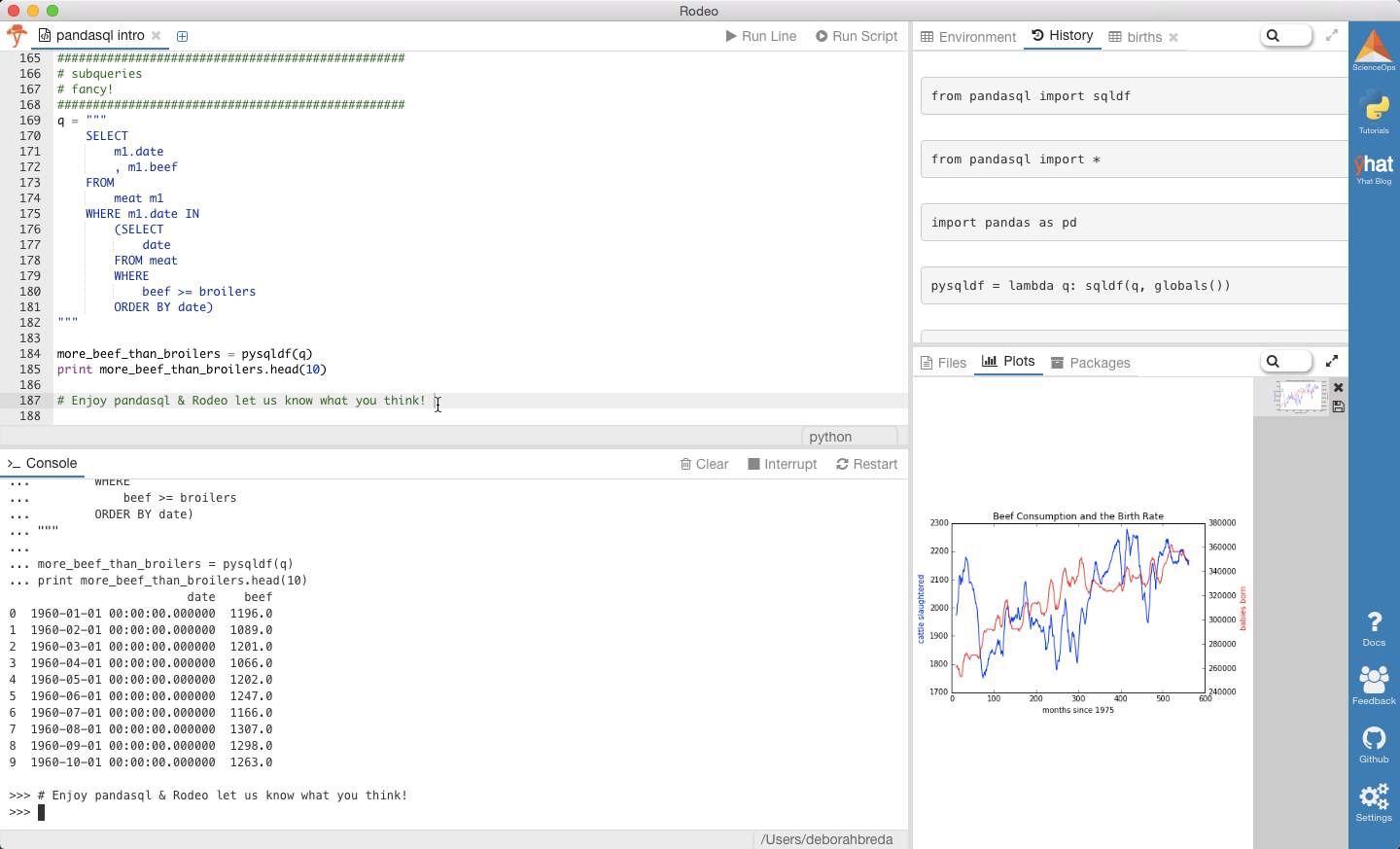
pandas is an incredible tool for data analysis in large part, we think, because it is extremely digestible, succinct, and expressive. Ultimately, there are tons of reasons to learn the nuances of merge, join, concatenate, melt and other native pandas features for slicing and dicing data. Check out the docs for some examples.
Our hope is that pandasql will be a helpful learning tool for folks new to Python and pandas. In my own personal experience learning R, sqldf was a familiar interface helping me become highly productive with a new tool as quickly as possible.
We hope you’ll check out pandasql and Rodeo; if you do, please let us know what you think!
